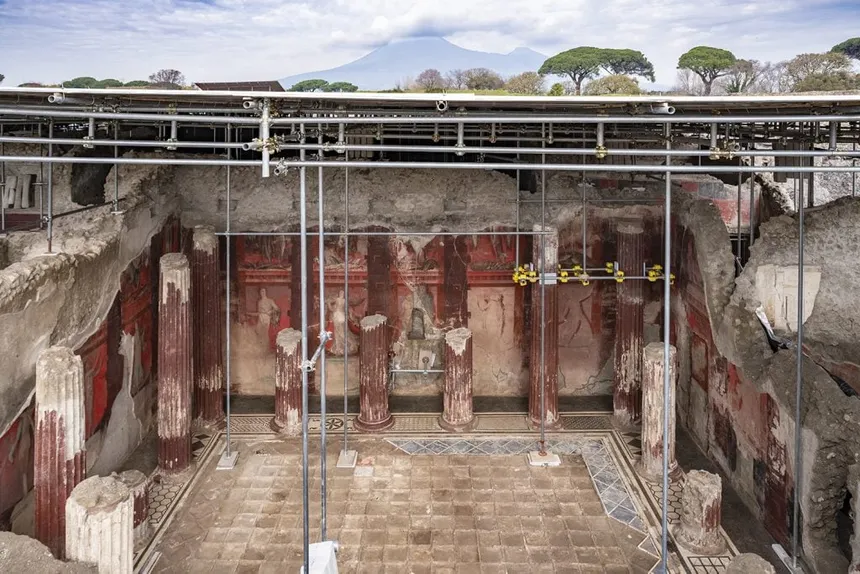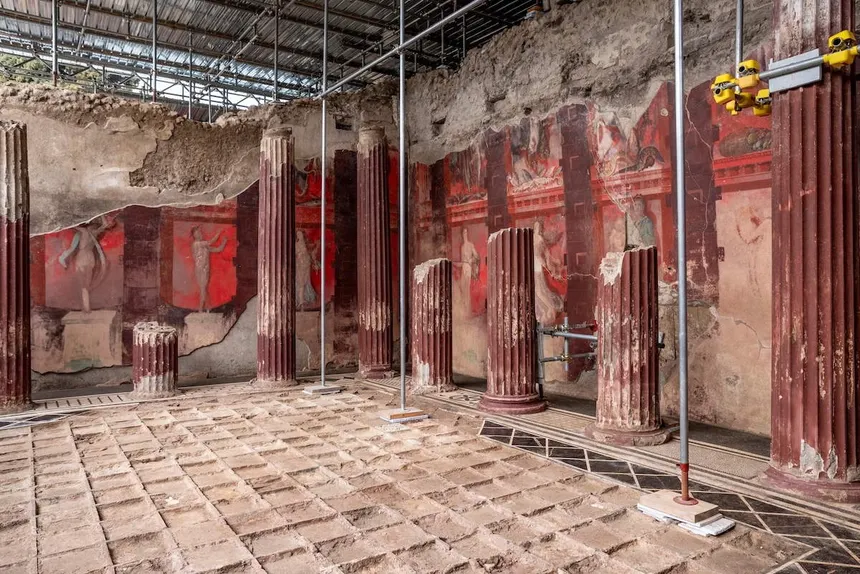A Stunning Discovery in Pompeii
A remarkable new discovery in the ancient city of Pompeii is offering fresh insights into the religious practices of its long-lost inhabitants. Archaeologists have uncovered a rare and well-preserved frieze that provides clues about how the people of Pompeii worshipped before the city was buried under volcanic ash in 79 AD.
The Discovery of the Frieze
- Found in a previously unexplored section of Pompeii, the frieze was buried under layers of ash and debris for nearly 2,000 years.
- The artwork is remarkably well-preserved, with vibrant colors and intricate carvings still visible.
- Experts believe it dates back to the first century AD, a period of rich religious and cultural activity in Pompeii.
- The frieze was discovered in a villa believed to belong to a wealthy Roman family, suggesting that such religious art was commissioned by the elite.
- Initial findings indicate that the artwork was part of a larger decorative scheme, possibly in a ceremonial room or a temple within the home.

What the Frieze Depicts
The frieze features a series of elaborate carvings and paintings that appear to depict sacred rituals and religious ceremonies. Some of the key details include:
Mysterious Figures and Rituals
- The artwork includes images of robed priests, sacred animals, and what appears to be a sacrificial altar.
- Some carvings show people engaging in processions, possibly honoring a deity or participating in a festival.
- The use of specific symbols, such as laurel wreaths and torches, suggests a connection to Roman religious traditions.
- Detailed inscriptions found near the frieze might provide additional context on the rituals performed.
- Archaeologists are analyzing whether the figures depicted represent historical religious leaders or mythological beings.
Possible Connection to the Cult of Dionysus
- Some historians believe the frieze may be linked to the cult of Dionysus, the Roman god of wine, fertility, and religious ecstasy.
- Depictions of grapevines, theatrical masks, and music in the artwork hint at Dionysian rituals, which were known for their elaborate feasts and celebrations.
- The discovery aligns with previous findings in Pompeii that suggest secretive religious groups gathered in hidden spaces to conduct ceremonies.
- The presence of female figures engaged in dance and music suggests an important role for women in these rites.

Why This Discovery Matters
This rare frieze is more than just a beautiful piece of art—it is a window into the spiritual life of ancient Pompeiians. Here’s why experts believe it is so significant:
A New Perspective on Ancient Religion
- The frieze challenges previous assumptions about the religious practices of Pompeii’s residents.
- It suggests that private or underground worship may have been more widespread than previously thought.
- The imagery offers fresh clues about how Roman religious traditions evolved over time.
- The discovery raises questions about the influence of Eastern religions on Roman society, as some symbols suggest foreign religious influences.
A Breakthrough in Archaeology
- The level of detail in the carvings and paintings provides researchers with valuable historical data.
- Advanced imaging techniques will allow scientists to analyze pigments and materials used in the artwork, revealing more about ancient Roman art techniques.
- The discovery encourages further excavations in lesser-explored areas of Pompeii.
- It provides a rare opportunity to study how art and religion intersected in daily Roman life.
How Scientists Are Studying the Frieze
Since the frieze’s discovery, a team of archaeologists, historians, and art experts have been working together to analyze and preserve it.
Restoration and Preservation Efforts
- Scientists are using state-of-the-art methods to prevent further deterioration of the artwork.
- Conservationists are developing techniques to maintain the colors and structural integrity of the frieze.
- The frieze is undergoing a delicate cleaning process to remove centuries of accumulated debris without damaging its original pigments.
- Chemical analysis is being conducted to determine the exact composition of the paints used, offering insight into ancient Roman painting techniques.

Decoding the Symbolism
- Historians are comparing the frieze’s depictions with other known examples of Roman religious art.
- Linguists are studying any inscriptions found near the artwork to translate potential religious texts or dedications.
- Experts are debating whether the frieze depicts a single historical event or represents an idealized version of multiple religious practices.
Public Exhibition Plans
- There are discussions about displaying the frieze in a museum, allowing the public to witness this rare piece of history.
- Digital reconstructions may be created to offer a virtual experience of the ancient artwork.
- Scholars hope to publish extensive research on the frieze to share their findings with the academic community and the general public.
- There are even proposals for a temporary exhibit at international museums, bringing the discovery to audiences worldwide.
Conclusion
The discovery of this rare frieze in Pompeii is a game-changer for historians and archaeologists alike. By unlocking new secrets about ancient religious practices, this find enriches our understanding of how people lived, worshipped, and celebrated over 2,000 years ago. As experts continue to study this stunning artifact, more revelations about the spiritual world of Pompeii may soon emerge. This frieze not only preserves history but also connects modern audiences with the rich, complex world of ancient Roman society.
Do Follow USA Glory For More Updates.






